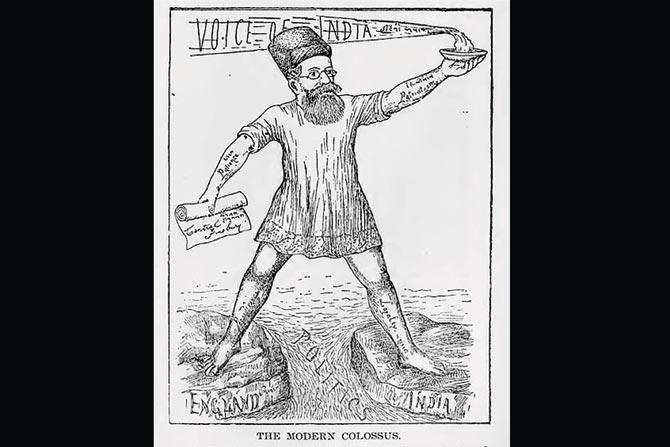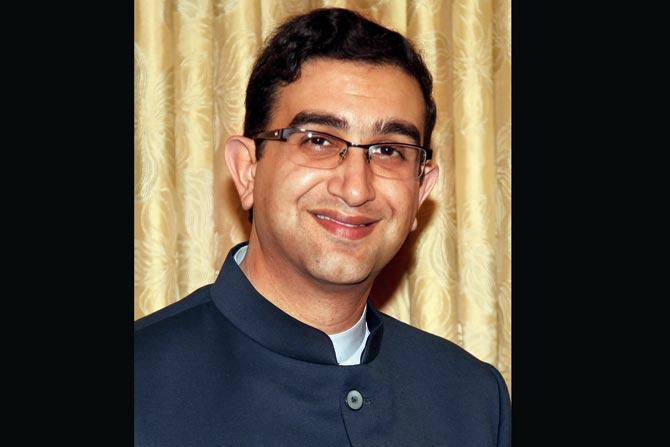New biography of the nationalist leader and educationist looks at how the city-s public education system and cosmopolitan character influenced a man who made his own destiny, and impacted that of the city that shaped him

The statue of Dadabhai Naoroji Dordi located at the intersection of Dr Dadabhai Naoroji Road and Mahatma Gandhi Road in Fort. Late in his life, Naoroji wrote an article where he claimed that his education, which came at the expense of the poor Indian taxp
THE moment a question was proposed to the class, he quickly took a step before the rest, contracted his brows in deep and anxious thought, and with parted lips and finger eagerly uplifted towards the master…The little fellow seemed wholly animated with the desire of excelling," writes Marianna Postans, British travel writer, as a member of the audience during a public examination for mathematics. She is referring to seven-year-old Dadabhai Naoroji Dordi, the Parsi scholar and Indian nationalist leader, who was already the star pupil at the central English school of the Bombay Native Education Society.
ADVERTISEMENT
Naoroji-s emergence as an educational visionary had its roots in his own struggle. Free education was a rarity back then, and certainly in India. Having lost his father when he was four, he was encouraged by Manekbai, his illiterate mother, to pursue vernacular and English education. "It broke the cycle of impoverishment, which had afflicted a family that had moved from Navsari in Gujarat to Bombay. It allowed him to meet and learn from the greatest minds. The education imbued him with a strong appreciation for rational thought and progressive politics," says Dinyar Patel, whose just-published title Naoroji HarperCollins is a definitive biography of the Indian leader, offering unique insights into his early life before he became a voice
for free India.
To understand Naoroji-s role in shaping Bombay-s education system, Patel delves into its 19th century status. The harbour city, he says, was unlike other colonial cities, Calcutta or Madras. "The British did not dominate everything: Indians were important stakeholders; the British knew this and hence had to work with Indians on political, municipal, and commercial matters. Consequently, Indians became important stakeholders in the project of free public education from which Naoroji had benefited [as a school boy], as well as later when at Elphinstone College, where he studied, and also taught. When the British authorities threatened to close it down in the 1830s due to low funding and attendance, it was the Indians who ensured that it remained open," he reveals.

Naoroji depicted as a colossus straddling England and India, indicating his dual roles as a British MP and an Indian representative. Review of Reviews New York, October 1892, p. 279. Reproduced from Thomas Cooper Library, University of South Carolina. He had faith in British justice and that they would see their wrongs and remedy them. Many junior radicals, like Bal Gangadhar Tilak and Bipin Chandra Pal, criticised Naoroji for this faith and urged him to let it lapse. But Naoroji had great faith in India and that given the chance, the country would rebound economically, educationally and politically
The Fort-based college, set up by then Governor Montstuart Elphinstone, was the epicentre of reformist thought. Many of Naoroji-s teachers and professors had been influenced by the Scottish Enlightenment, and they passed along their ideas and beliefs to the students. "He knew that education was a political imperative. The Peshwas had supported education and patronised certain teachers, and the British knew that it was politically expedient to keep up this legacy." By the late 1840s, Naoroji was already an assistant professor at the college; and in 1851, while still in his late 20s, he was appointed to the Bombay Board of Education. In 1854, he was the first Indian to become a full professor mathematics and natural philosophy, in a British-administered institution of higher education.
Along with other scholar-thinkers such as like Mahadev Govind Ranade and Gopal Krishna Gokhale, he believed that something had gone wrong in India; a rich country barely a century ago, was now reeling under extreme poverty. Education across genders and classes, they felt, would allow for religious, social, and eventually political reform that would help regenerate India. Bombay-s famed heterogeneity where no one religious/ethnic group dominated, helped facilitate cooperation and give wings to their vision, reveals Patel. He also touches on Naoroji-s involvement in Parsi religious and social reform, explaining how he petitioned for the scrapping of certain religious beliefs and practices, and changing specific social conventions of members of the Parsi Zoroastrian community to allow more freedom to women. See box
These initiatives by Naoroji and fellow reformers led to what was called the Young Bombay Movement. "I think that it [the movement] had a longer life than we give it credit for. The city-s politics has changed tremendously since the late 19th century, and a lot of the progressive civic consciousness seems, unfortunately, to be lost. Yet, it survives in different ways, such as in the persistence of our cosmopolitanism in spite of political pressures. There is a reason why people still flock here and not to other major urban centres: it still represents change and opportunity," Patel thinks.

Dinyar Patel
In the second half of his long, illustrious life, Naoroji played a critical role in the Indian nationalist movement and was the first Indian to be elected to the British Parliament. His political campaigning was often a thankless task, but he knew that the fate of millions of countrymen rode on his ability to affect change. Back in India, he continued propagating an ideology that was later carried forward by Mahatma Gandhi, who also believed in Indian nationalism as part of a broader emancipatory struggle, one that represented the colonial, non-white world.
There-s a seated statue erected in honour of Dadabhai Naoroji at a pivotal traffic junction in Fort. As the city comes together to grapple with the modern-day enemy in the guise of a pandemic, one wonders how a visionary like him would have inspired the public, just the way he did 150 years ago, while envisioning the original idea of Bombay, and Swaraj for India.
Supporter of institutions
Between 1848 and 1855, Dadabhai Naoroji took a leadership role in a variety of new associations. He was the founder and first editor of the Parsi Lekhak Mandli, a society for Parsi writers. He helped raise funds for the Framji Cowasji Institute at Dhobi Talao, which gave the city’s residents a new forum to hold lectures and public gatherings. He was also a founding member of the Parsi Natak Mandli Dramatic Society. Thanks to the staging of a Gujarati rendition of Rustom and Sohrab in October 1853, this association was able to sow the seeds of Parsi theatre.
The practical professor
At Elphinstone College, Naoroji lectured on mathematics, astronomy, and natural philosophy. Often, he would give his students outdoor lessons under the night sky to reinforce astronomical principles. He convinced members of the famous Wadia shipbuilding family to allow them to see their dockyard at Mazagaon and the inside of an anchored steamer. He also took them to Bori Bunder station to inspect the steam locomotive that plied the Great Indian Peninsula Railway.
Courtesy: Naoroji by Dinyar Patel
Catch up on all the latest Mumbai news, crime news, current affairs, and a complete guide from food to things to do and events across Mumbai. Also download the new mid-day Android and iOS apps to get latest updates.
Mid-Day is now on Telegram. Click here to join our channel @middayinfomedialtd and stay updated with the latest news
 Subscribe today by clicking the link and stay updated with the latest news!" Click here!
Subscribe today by clicking the link and stay updated with the latest news!" Click here!







